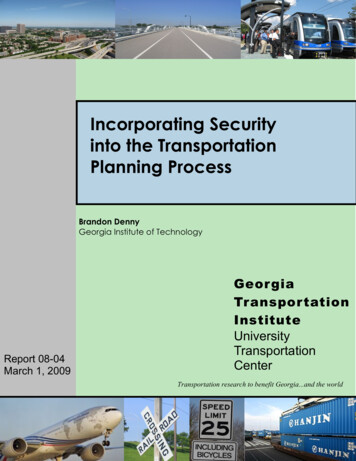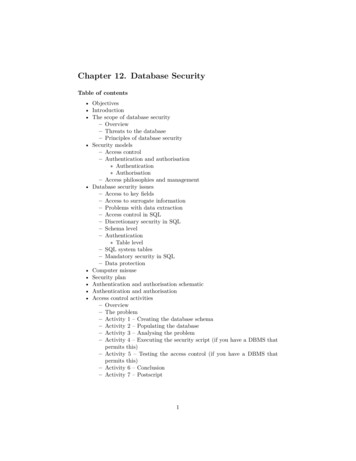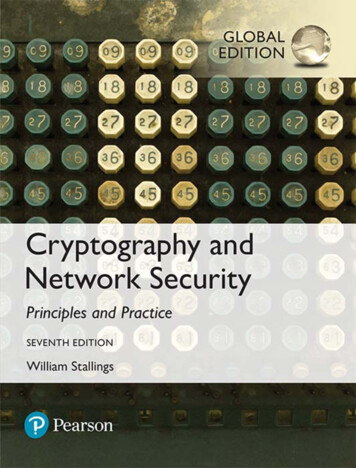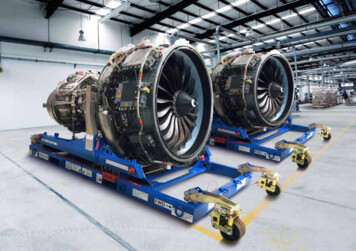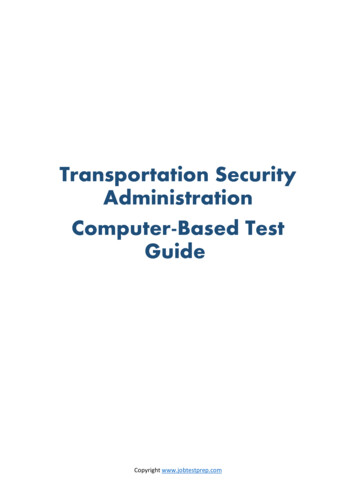
Transcription
Transportation SecurityAdministrationComputer-Based TestGuideCopyright www.jobtestprep.com
ContentsAbout the Test . 3Getting Ready. 4X-Ray Section . 4About the Exam. 4X-Ray Images . 4Our Drills . 5Recognizing different items . 6The English Section . 9Tips . 102
About the TestThe Study GuideTSA's hiring process involves six steps:1.2.3.4.5.6.Computer-based examTSA color vision examInterviewDrug screenMedical evaluationExtensive background investigationThis study guide aims to prepare you for the TSA Computer-Based Test. In this guide you will find athorough explanation regarding the X-Ray Object Recognition test as well as an introduction to theEnglish section. Moreover, this guide includes helpful tips for the assessment day.Inside our pack, you will find a diagnostic test to help you study in an effective way, practice drills forthe X-Ray and English Sections, and also materials that will prepare you for the interview. Make sureto read the guide and then solve the drills.3
Getting ReadyX-Ray SectionAbout the ExamThe X-ray exam is not a typical aptitude test. It is unique and based on alertness and decision-makingskills. You will be asked to identify items in X-ray images of luggage which have been shown brieflybefore the test. Your main task will be to determine if the required items appear in the pictures ornot. Our test is comprised of a set of pictures, one picture at a time. You will have a few seconds topress a certain key that indicates whether the requested item appears in the image or not. Thepictures will be changed automatically after a few seconds.X-Ray ImagesExample of an X-Ray ImageX-Ray machines present images that are colored based on the density of the scanned items. Thedenser the material, the darker it will appear. When preparing for the X-Ray section, practice helpsa great deal since it allows you to become familiar with the characteristics of targeted items.However, keep in mind that different machines may have different color settings, and although mostitems will appear in the same way in different bags, they might appear differently in other bags.Blue represents dense materials, such as metal, hard (dense) plastics and different parts ofweaponry. When the material is very dense, the blue may get darker to the point of black. Forexample, a metal box or wires will show up as blue or black and, often, as a mix of both colors.Green represents less dense materials such as plastics and alloys (less dense metals). Green is shownwhen a product includes a material with lighter density than dense metals, but denser than organicobjects. Stones, ceramics, plastic, and toys may be colored green.Orange represents the least dense material, which is mostly biological material. All organic objectssuch as wood, food, plants, animals, powders, rubber products and leather will show up as orange.Sometimes plastic bottles are seen as orange.Remember: Although most guns, knives and grenades are made of metal, they might come indifferent densities, thus appearing in the X-Rays as green or even orange!4
Our DrillsThe purpose of our drills is to prepare you for this X-Ray Section. Each drill will begin with a smalltimed (45-70 second) introduction and a description of the task. The introduction will present acertain item, which you will have to look for, and examples of it. When the time is up, theintroduction will automatically change to the drill, and a set of images will be shown, one at a time,for 15 seconds. Press '1' if that certain item appears, or '3' if it does not. Each drill has its own theme(guns, knives and even ordinary objects), and will include 10-20 images per set.Tips for Practicing Bags ScanningYour object-recognition skills will improve if you practice using these tips. TSA may use differentcolors or items, therefore having solid methods for object-recognition can prevent you from beingsurprised. Search the items using a method to make sure you don't miss anything. Try scanning thebags in snake-like movements or dividing the suitcase into four parts and searching each oneseparately (as shown in the pictures below). Don’t forget to examine the outlines of thesuitcase/bag for items that might be hidden there. Look at the general outline of the objects when looking for a specific item.Some objects are comprised of more than one material and therefore we should integratethe colors into one shape.When the required item is not found and the time is about to end, assume that the itemdoes not appear in the image and press '3' instead of leaving it blank. This type of questionrequires experience and familiarity with the scanned objects. Under time constraints, it iscommon to mistake ordinary objects for targeted objects. Therefore, you should only mark‘1’ if you actually see the targeted object.When the pictures of the items are presented in the introduction, please do not search forthe exact same item in the images that follow. The introduction is just an example; forinstance, if a high-heeled shoe is presented, the following images might contain a man'sshoe since they both belong to the same category. Also, the angles in which the item ispositioned in the picture may change, so visualize suspicious items in different angles.In some X-Ray images, the outline of the required items might be difficult to recognize.Therefore, try to focus on the possible colors of the required item.Do not press “next” to move to the next question; keep your fingers on the '1' and '3' keys inorder to avoid any confusion.Be focused. The images change rapidly, so being alert will help you succeed in the test. 5
Recognizing different itemsGuns –Guns come in different sizes, types and colors. Most of the types share the same distinctive featureswhich can allow you to identify them on an X-Ray scan:1. Slide - This is the top part of the gun which houses the firing pin and the extractor. It isusually the densest part of the gun, and therefore it usually has the darkest color.2. Trigger - The trigger is the mechanism which actuates the firing sequence of the gun. It maybe hidden in some angles, while in other X-Ray scans it may become a distinctive featurewhich is crucial to identifying the gun.3. Grip – This is the part which is used to hold the gun. It includes a space designated for amagazine. In the given picture you can see a magazine is inserted. Notice the spring, which isa part of every magazine. In the picture above you can see a zigzagged line inside the grip.This is the magazine’s spring.Like other objects, guns may appear in various angles, making them hard to identify. You can seesome of the angles in the picture below:6
Grenades –The grenade includes two prominent features; the Lever and the Safety Pin (as shown in the picturebelow):The body of the grenade appears mostly in green or blue. However, it is better to learn to identify itsparts rather than relying on the colors, as they may appear different in other X-Ray machines. Hereare some examples of different colors and angles you can find grenades in X-Ray Scans:Knives –The TSA test asks you to identify different kinds of knives, from big knives to utility knives, sharp nailfilers, and even scissors:7
Electronics –Electronic items can appear in an X-Ray image. Each has its own unique traits, although mostelectronic items share the following traits:1. A plug – The plug indicates the item is electronic. The following example is a standardEuropean plug, but there may be different kinds.An example of a plug2. Colors – Many electronic items have a plastic wrap and inside of it are metal parts – forexample cellphones, laptops and blow-dryers. The density of the metal parts shows as greenor blue, thus you can notice the chips, batteries, wires and other metallic components insidethe electronic item.Examples of electronic itemsOther Items –In some states the TSA may include other items in the X-Ray sections, such as pens, flashlights,smartphones, dolls, tools and more.This should not alarm you. Scanning an X-Ray image is a skill, and practicing is the way to master it.Every item given in the exam will be shown in a preview, prior to the questions. Learn the item’straits and use them to locate it in each question, as you practiced.Examples of different items8
The English SectionThe pack contains questions from three main topics:1. Reading Comprehension – You will be provided with written passages, each of which will befollowed by multiple-choice questions. Questions may be given on a basic, intermediate,and/or advanced level.2. Vocabulary – This part of the TSA assessment evaluates your vocabulary knowledge, spellingcapabilities when recognizing words that are spelled incorrectly and correctly, aptitudewhen finding two words with opposite meanings (antonyms), and ability to identify twowords with the same meaning (synonyms).3. Written Communication – This part measures your ability to choose the sentence thatpresents the provided information in the best way, as well as how well you organizesentences into paragraphs and make restatement choices. You will also be scored based onhow efficiently you organize ideas in a logical manner, and how you can recognize correctand incorrect punctuation and capitalization. Additionally, you will be assessed based onyour English grammar, sentence completion, and proper use of syntax skills.Practice makes perfect! There are a lot of drills for the English sections inside the pack. To studyeffectively, make sure you work on the topics you find more difficult. In addition, inside the pack youwill find instructive videos and study guides for specific subjects.9
TipsBelow are tips that will prevent you from being surprised on assessment day: Identifying objects in X-Ray images that are different from those that appear on the pack:Keep your cool! Remember that before each question you will be given a short period oftime to view an object. Take a close look at it, try to understand what it is made of, so youwill know what density to expect and visualize it in different angles. Make sure you scan theimages as you practiced. Some states may have items appearing in the X-Ray objectrecognition section that are different from those in the pack.The X-Ray Images have different colors or appear in black and white:Again, do not panic! The principles of X-Ray image scanning stay the same: Scan the bag asyou practiced and search for the distinctive features of the items you are looking for.In black & white images denser materials (metal) will appear in darker colors, while organic(less dense) material will appear brighter.In images with different sets of colors it is important to pay attention to the introduction. Itwill present to you how the colors indicate the density of the material. Do not forget to scanthe images using the methods you practiced. Most states use the colors that appear in thispack. However, some states may use X-Ray images with different colors or black and whitecolors.Good Luck!10JobTestPrep
The Study Guide TSA's hiring process involves six steps: 1. Computer-based exam 2. TSA color vision exam 3. Interview 4. Drug screen 5. Medical evaluation 6. Extensive background investigation This study guide aims to prepare you for the TSA Computer-B
